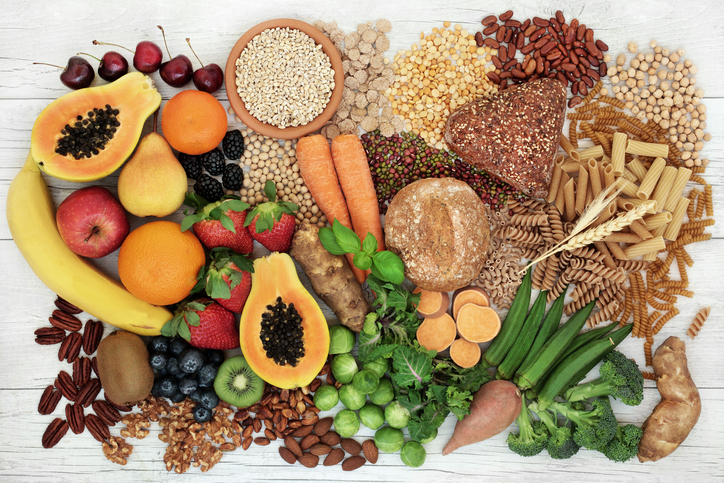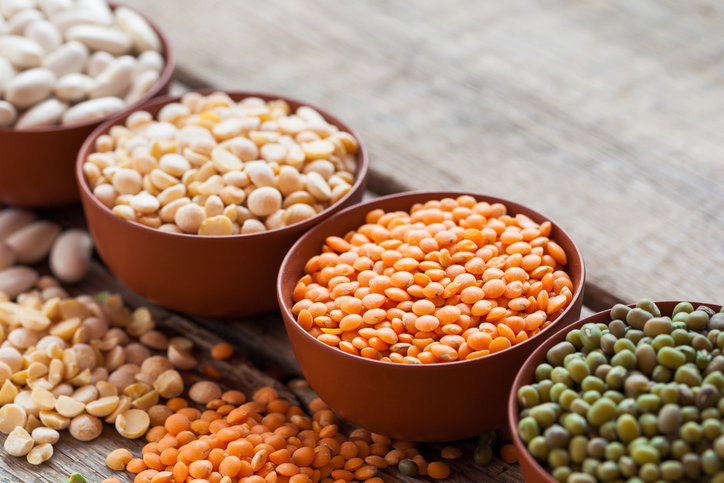- solen.cz - Fibre
- vup.sk - Fibre in food
- mayoclinic.org - Dietary fiber: Essential for a healthy diet
- ncbi.nlm.nih.gov - II. DEFINITIONS OF DIETARY FIBER
Fiber: Insoluble food component, prevention and cure? + Daily intake

Fibre is one of the important food components that has started to disappear from our diets over the years. Originally, humans used to consume much more of it, but it is gradually making a comeback in our diets due to its beneficial effects.
Article content
Dietary fibre is a soluble and insoluble and indigestible component of food. It varies from food to food. How much fibre do we need each day, why is it important? What is it for?
+ Table of dietary fibre content in the article...
The incidence of various diseases of civilization is mainly attributed to improper nutrition.
Around the 1960s and 1970s, the emergence of many diseases began to be linked to a lack of fibre. Today, the issue is widespread almost worldwide and fibre has come to the fore in the context of disease prevention and health promotion.
Fiber should be taken in much more than it is currently because of its positive properties towards the body.

What is dietary fibre anyway?
It is a food component, mostly of plant origin, which is itself difficult to digest. Nevertheless, it makes a significant positive contribution to the digestive process. It is divided into soluble and insoluble according to its solubility in water.
Soluble fibre
In the intestinal system, this fibre is not broken down. However, it is fermented by intestinal bacteria, i.e. fermented. In the colon, this produces fatty acids and gas. The formation of fatty acids can be used as an energy source. It serves as fuel for the intestinal cells and also has a protective function.
By creating an acidic environment, it inhibits the growth and multiplication of putrefactive bacteria. On the contrary, it promotes the multiplication of fermentative bacteria. These include pectins, guar gum, gum arabic, inulin and fructooligosaccharide.
Insoluble fibre
Insoluble fibre does not ferment and passes through the digestive tract unchanged. However, it acts like a sponge in the large intestine. It is able to absorb several times more toxins than its volume. The toxins produced during the digestive process are thus trapped and carried out of the body.
This group includes cellulose, wheat and corn bran, oat husk fibre and resistant starches.
Soluble and insoluble fibre is found in different amounts and proportions in foods. It is therefore ideal to eat more than one type of fibre-containing food.
Definition of fibre
In the early days, only that part of the food that was resistant to digestion by digestive juices, increased the volume of intestinal contents and promoted bowel movement was considered fibre. This most commonly included cellulose and lignin, which form a group called crude fibre.
Today, however, it is known that there are many more indigestible plant polysaccharides that are beneficial to the human body. If we include hemicelluloses and pectins in this group at the same time, this is the so-called dietary fibre. However, the term fibre also covers other food components such as plant gums and mucilages.
In 1998, the American Association of Cereal Chemists (AACC) proposed and approved a definition of dietary fibre, which states that fibre consists of edible plant parts or analogous carbohydrates that are resistant to digestion and absorption in the small intestine and are fermented - broken down by fermentation in the large intestine.
According to them, fibre includes polysaccharides, oligosaccharides, lignin and associated plant constituents.
Dietary fiber has benefits for the body such as laxative effects, ability to lower cholesterol and blood sugar.
Food fibre components in the table
| Non-starch polysaccharides and resistant oligosaccharides | Cellulose hemicellulose (arabinoxylans, arabinogalactans) polyfructosans (inulin, oligofructosans) galactooligosaccharides gums mucilages pectins |
| Analogous carbohydrates | indigestible dextrins - resistant maltodextrins, resistant potato dextrins Synthetic carbohydrate-based compounds - polydextrose, methylcellulose, hydroxypropylmethylcellulose, indigestible (resistant) starch |
| Lignin | |
| Components accompanying complexes of non-starch polysaccharides and lignin in plants Waxes | waxes phytates cutin saponins suberin tannins |
Fibre is divided into soluble (pectin, inulin, some hemicelluloses, plant mucilages, rubber, resistant starches, fructooligosaccharides - in fruit, oats, malt, legumes, potatoes) and insoluble (lignin, cellulose...).
Common properties of fibre are its resistance to hydrolysis by digestive enzymes, its ability to pass into the colon unchanged and its ability to influence certain gastrointestinal functions.
Other properties of dietary fibre:
- ability to bind certain vitamins, trace elements, calcium and cholesterol
- binds certain toxins, thus protecting not only the intestinal mucosa but also the whole organism
- it also regulates the digestion of fats and sugars
- it is partly a nutrient for the microbial flora, thus acting as a prebiotic
- slows down the absorption of sugar into the blood, thus keeping sugar levels more stable
- reduces the risk of gallstones and colon tumours
- can bind fatty acids, bile acids and sterols, reducing the absorption and production of LDL (bad cholesterol)
- speeds up the passage of food through the intestine, thus ensuring shorter exposure of the intestinal wall to potentially harmful substances and metabolic wastes
- binds water, leading to a feeling of satiety during weight loss and reduction diets
Also read the magazine article on probiotics.
What is the recommended amount of fibre?
Currently, the average amount of fibre intake by one person is about 15 g per day. However, recommendations are around 30 g per day.
However, an intake of more than 60 g per day is considered risky.
The recommended daily intakes of dietary fibre by age or sex are shown in the table below
| Age category | Grams per day |
| Infants 7-12 months | 3 |
| Preschool age 1-3 years | 10 |
| Preschool age 4-6 years | 14 |
| School age 7-10 years | 17 |
| School age 11-14 years | 18-20 |
| Adolescents 15-18 years | 18-25 |
| Working women 19-54 years | 22-26 |
| Pregnant and breastfeeding women | 26-28 |
| Non-working women 55-74 years | 20 |
| Non-working women over 75 | 18 |
| Working men 19-59 years | 24-30 |
| Non-working men 60-74 years | 22 |
| Non-working men over 75 | 20 |

For children, fibre-containing foods should be introduced gradually, not a large amount at a time.
You may also be interested in the article: Our bodies need omega-3 fatty acids. Do we get enough of them?
Sources of fibre
Dietary fibre is a carbohydrate. It occurs naturally in all foods of plant origin.
Legumes, rye bran, whole grains, cereals and soy are excellent sources.
As far as fruit is concerned, insoluble fibre is mainly found in the skins of fruits such as apple, pear and grapes. Fruits such as citrus fruits, bananas and currants are sources of soluble fibre.
Among vegetables, broccoli, cauliflower, dill, carrots, cabbage, peppers, tomatoes and lettuce contain the most fibre.
Flax seeds, seaweed, seaweed and mushrooms, including oyster mushrooms, contain fibre in the form of plant mucilage.
The table lists the sources, together with the fibre content
| Source | g/100 g | |
| Fruit | ||
| Pears | 2,4 | |
| Cranberries | 2,9 | |
| Nectarines | 2,2 | |
| gooseberries | 2,8 | |
| blackcurrants | 5,6 | |
| Red currants | 4,7 | |
| white currants | 4,0 | |
| raspberries | 5,2 | |
| blackberries | 4,0 | |
| blueberries | 2,2 | |
| black elderberry | 6,0 | |
| rose hips | 22,4 | |
| oranges | 1,8 | |
| lemon | 1,8 | |
| bananas | 3,1 | |
| pomegranate | 2,8 | |
| Nuts | ||
| coconut | 7,3 | |
| Pine nuts | 1,9 | |
| walnuts | 2,7 | |
| hazelnuts | 3,5 | |
| Chestnuts | 4,0 | |
| peanuts | 6,2 | |
| pistachios | 6,1 | |
| cashew nuts | 3,2 | |
| almonds | 6,0 | |
| fresh dates | 3,6 | |
| Dried dates | 7,8 | |
| figs fresh | 2,3 | |
| Dried figs | 12,4 | |
| Vegetables | ||
| Celery | 3,7 | |
| Carrots | 3,0 | |
| Horseradish | 6,2 | |
| parsnips | 4,3 | |
| spinach | 2,1 | |
| garden cress | 3,3 | |
| parsley stems | 5,0 | |
| aubergine | 2,3 | |
| chives | 2,0 | |
| asparagus | 1,8 | |
| Fennel | 3,3 | |
| Legumes | ||
| Red lentils peeled | 13,2 | |
| Large grain lentils | 15,0 | |
| Red coloured beans | 20,1 | |
| coloured beans | 17,3 | |
| White beans small | 24,5 | |
| White broad beans | 19,2 | |
| peas shelled whole, yellow | 12,6 | |
| green peas | 20,4 | |
| soya | 19,4 | |
| chickpeas | 16,9 | |
| Herbs and pepper | ||
| bay leaf dried | 26,3 | |
| Fresh basil | 5,2 | |
| dried basil | 17,8 | |
| cinnamon | 14,4 | |
| cumin | 10,5 | |
| Fennel seeds | 39,8 | |
| Dried marjoram | 18,1 | |
| dried mint | 44,7 | |
| nutmeg | 23,7 | |
| dried oregano | 42,8 | |
| spicy paprika | 20,9 | |
| black pepper | 26,5 | |
Fibre can also be taken in the form of food supplements. However, the quality of the product should be checked. It should contain real fibre, which has beneficial properties for the body, and not just an expensive commercial product containing cellulose.

Too much of everything is bad. Even fibre?
Foods rich in fibre, especially those of plant origin, usually contain substances that reduce the ability to absorb certain minerals and macro and micro elements. In theory, artificially increased levels of fibre in the diet could therefore lead to a deficiency of components such as iron, zinc, magnesium or calcium.
In some individuals, high fibre intake can cause bloating, abdominal pain and diarrhoea. However, such problems are usually temporary and usually subside gradually.
The occurrence of possible adverse effects can be expected especially in the elderly and young children.
You may also be interested in articles on weight loss and healthy lifestyle:
Vláknina a jej príjem
Interesting resources
Related










